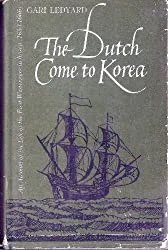The Dutch Come to Korea by Gari Ledyard. (Seoul: Royal Asiatic Society—Korea Branch, 1971.)
Although it’s not the easiest book to buy these days, The Dutch Come to Korea is a great resource for anyone considering the idea of using a Korean-inspired fantasy setting like Jeosung as part of a wider world setting, or as a setting in which non-native characters could find themselves and undertake adventures. It consists of a translation of the diary of Hendrick Hamel (1630 – 1692), a “Hollander” employee of the Dutch East India Company who happened to be the first Westerner to write a published account of Korea, as well as historical notes and information that supplements the diary with historical context, biographical information about Hamel and the other Westerners who arrived in Korea with him, as well as some information about the text and its reception in Europe.
Hamel’s arrival in Korea couldn’t be more dramatic: while sailing from Batavia (today known as Jakarta) to Nagasaki, his ship De Sperwer (The Sparrow) was struck by a powerful storm, went off-course, and was wrecked off Jeju Island, off the southern coast of Korea. Including Hamel, thirty-six men survived the wreck and ended up on the island, and soon after that in the custody of the local government. Due to the geopolitical situation at the time, official government policy forbade the men to leave, and so they spent thirteen years trapped in Korea, shuffled from Jeju to Seoul and then out to the south western countryside, until finally they managed to escape to Japan and to liberty.
Obviously, the geopolitics of a fantasy-Korea like Jeosung won’t exactly match those of Joseon when Hamel arrived: it’s not as if pressures from China and Japan will exist to force Jeosung’s leaders to keep trespassing foreigners imprisoned in the land and the subject of an international cover-up. However, it’s easy enough to think of other reasons why outsiders might end up being temporarily trapped in the land: maybe passage home could be magically blocked, or there might be some kind of quest objective that brings them to Jeosung with the motivation to stay until they achieve it.
Likewise, the shifting fates and occupations of Hamel and those of his men who survived the entire sojourn definitely is suitable for an episodic RPG. They went from being generously treated guests, to virtual slaves and beggars, to official members of the royal guard, to near-forgotten exiles in the countryside, to (when only twelve of them remained) fugitives on a small fishing boat fleeing into Japanese waters. At one point early during their stay, soon after they arrived in Seoul, they were even pushed to use their knowledge in cannon-making for the benefit of the kingdom’s military: it was only after strenuous effort that they managed to convince anyone of the fact they didn’t know the first thing about how to make one! Of course, if Joseon had the likes of magical monsters and dokkaebi to deal with on a regular basis, it’s easy to imagine that a stint as monster-hunters could have featured somewhere in that series of careers, especially if the group included some seasoned adventurers.

Woodcut of Hamel and the other survivors of the wreck of De Sperwer, when they were taken to see the king in Seoul. This image is from the original book, but is one of several reproduced in Ledyard's book.
Woodcut of Hamel and the other survivors of the wreck of De Sperwer, when they were taken to see the king in Seoul. This image is from the original book, but is one of several reproduced in Ledyard's book.
Similarly, there’s a moment that’s just too good not to include in your game: when Hamel’s group arrives in Seoul, they’re taken to meet a man named “Yon” whom they are surprised to find sports a blond beard: suddenly, they realize, he’s another European, one who seems to have been in Korea a long time, and who was fluent in Korean. If you’ve got foreign player characters wandering the countryside, there’s no surprise more unusual than for them to run into someone from “back home” who came before them, and went native. (It’s also a useful trick for introducing someone to translate, if linguistic difference or the language barrier factors into your game.)
One last thought: for a long time in Europe, Hamel’s journal the first and the last word regarding Joseon (Korea). If you’re running a campaign for players in some foreign land whom you hope to entice into voyaging to Jeosung, this might be a great in-world item for them to run across. While you definitely can’t hand players a copy of Hamel’s diary as an in-world book, creating an imaginary in-world book circulating in their land, describing the strange wonders of Jeosung from the perspective of one of their countrymen or countrywomen, could be all the enticement they need.
Oh, and if interlibrary loans fail you and you find it impossible to get your hands on Ledyard’s volume, then Henny Savenije’s long-standing website about Hamel is a pretty good alternate source. If you just want the highlights, you might find this essay sufficient.
You may be able to find The Dutch Come to Korea on Amazon.
on Amazon.
